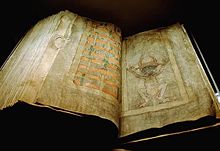Codex
Appearance


A codex (plural codices) is a book-like object with writing on it.[1] On a codex there are separate pages bound together at one edge, whereas a scroll is one continuous long document. The term is used for book-type objects written by hand, and includes books written on vellum or parchment.
The codex transformed the shape of the book itself. As an object, books can last for centuries, and many codices are in the great modern libraries.[2] The codex was first described by the 1st-century AD Roman poet Martial, who praised it. The codex was as common as scrolls by about AD 300.[3] It had completely replaced scrolls in the Greco-Roman world by the 6th century.[4]
Related pages
[change | change source]References
[change | change source]- ↑ Oxford English Dictionary, 2nd ed: Codex: "a manuscript volume".
- ↑ Lyons M. 2011. Books: a living history. London: Thames & Hudson, 8.
- ↑ "Codex" in The Oxford Dictionary of Byzantium, Oxford University Press, 1991, 473. ISBN 0195046528
- ↑ Roberts, Colin H. & Skeat T.C. 1983. The birth of the Codex. London: British Academy. pp. 15–22; 75. ISBN 0-19-726061-6
